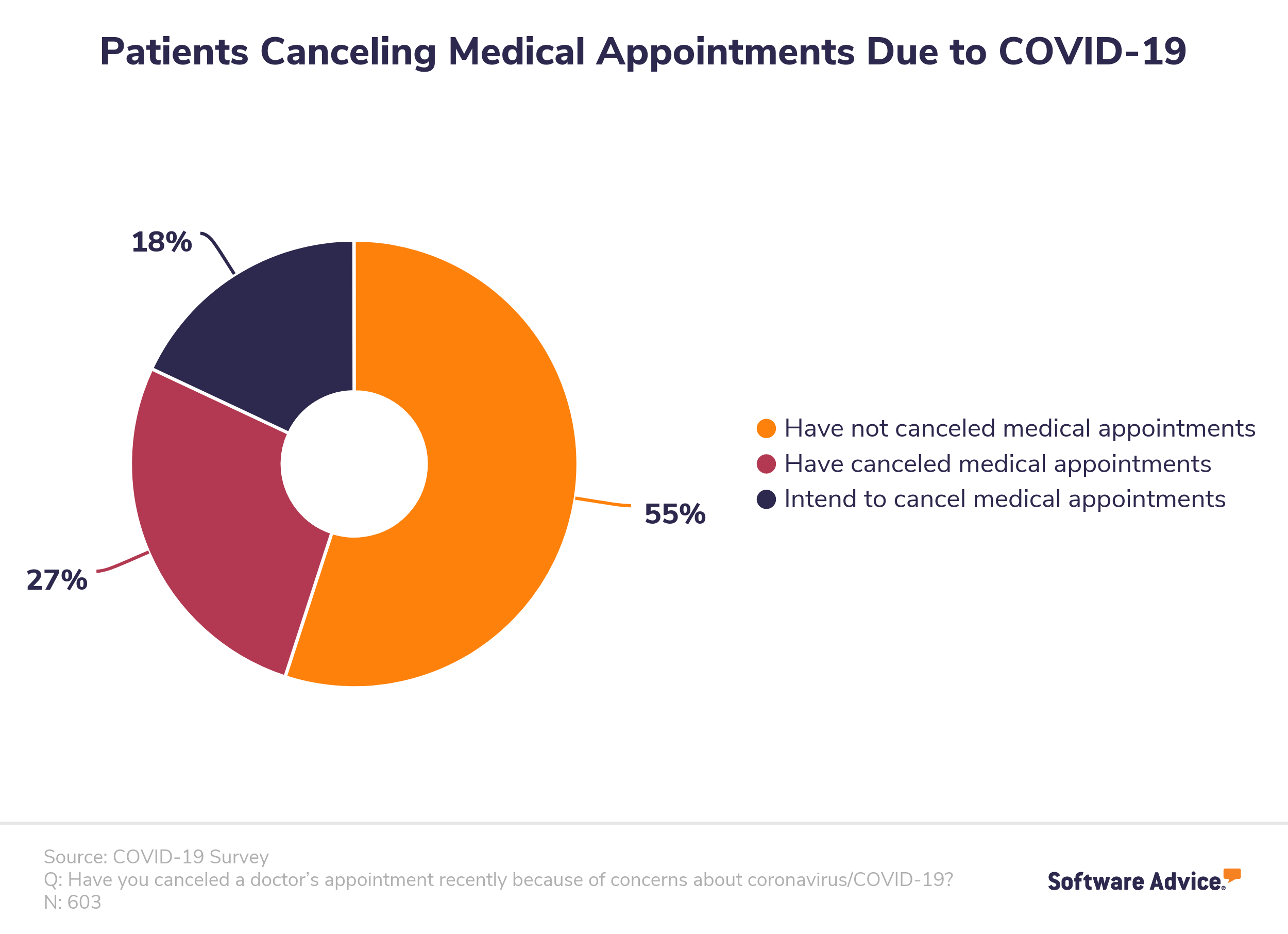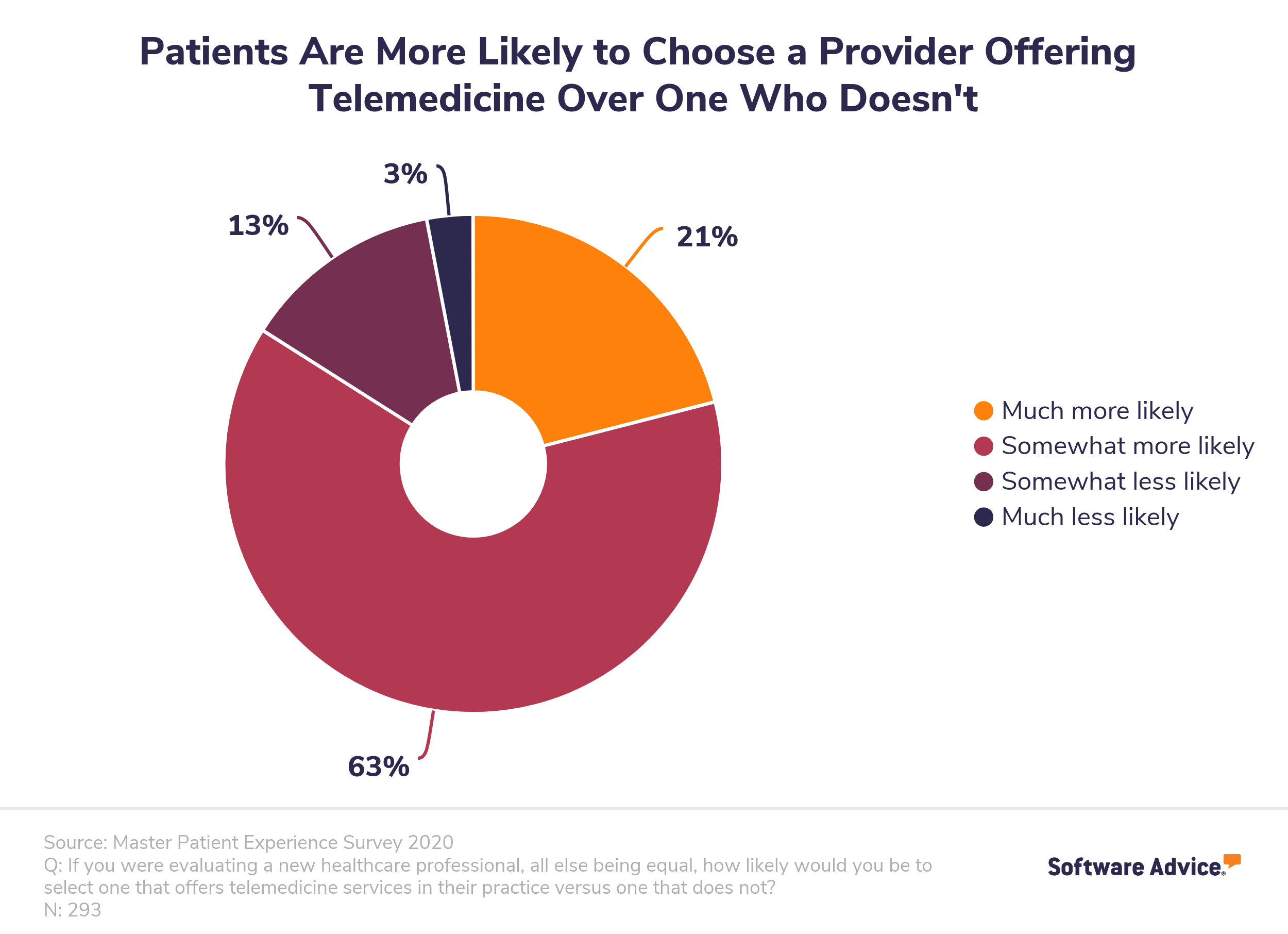What You Need to Know About Telemedicine in the World of COVID-19
COVID-19 is drastically changing how doctors and patients interact with each other. Limiting the spread of COVID-19 through social distancing is the recommended practice, and, as such, people have been encouraged not to go into the doctor. Even if a patient suspects they have COVID-19, many hospitals are encouraging patients to avoid going to the emergency room and to call their doctor first.
We see this caution represented in a recent survey* we ran:

Forty-five percent of patients canceling or intending to cancel appointments is significant. If your practice can make up some of that ground by providing telemedicine as an alternative, you’ll be better suited to meet the demand and maintain best practices.
This increased demand for telemedicine means a surge in the use of telemedicine software, but it’s also causing a strain on medical facilities as they struggle to deal with the increased demand for this service.
How telemedicine is being used during the COVID-19 pandemic
Telemedicine has traditionally been used to let doctors provide care remotely, typically through video conferencing via software with increased security features to ensure HIPAA guidelines are followed.
As mentioned, the primary reason telemedicine is seeing such a drastic surge in use is to reduce the chances of spreading COVID-19. It’s a no-brainer that telemedicine should be one of the first options in this health crisis for doctors to screen potential COVID-19 cases to determine if they qualify for testing.
If a patient is presenting COVID-19 symptoms (fever, cough, or shortness of breath), they can connect with their provider via telemedicine software. The provider can then advise them based on their assessment, all without person-to-person contact.
Because people are being told to avoid hospitals and doctors’ offices unless it’s an emergency, many people are skipping their regularly scheduled appointments. With telemedicine, those patients, in certain circumstances, won’t have to miss their consultations.
Emergency laws passed to increase access to telemedicine
President Trump signed the Coronavirus Preparedness and Response Supplemental Appropriations Act into law on March 6. The act gave Health and Human Services Secretary Alex Azar the ability to remove restrictions for Medicare beneficiaries around telemedicine use.
The bill’s purpose is to give practitioners the ability to examine elderly patients, those facing the most risk with COVID-19, while still getting paid by Medicare. However, several limitations were initially spotted in the bill that kept hospitals from providing free visits for Medicare patients via telemedicine services.
Fortunately, Medicare announced Tuesday it will expand their telemedicine coverage to give seniors more access to telemedicine options.
Now, elderly patients can still maintain regular checkups with their doctors for ongoing conditions without having to leave their home, and doctors still get paid for their time.
Should you consider telemedicine as an option?
The biggest limitation for telemedicine right now is software. Many practices don’t have telemedicine software and are suddenly scrambling to find a solution. Rolling out new software is time-consuming under normal circumstances, so this rush is leaving practices struggling.
Not only are practices struggling, but according to CNBC, telemedicine providers are also struggling to keep up with the increased demand. Whether it’s a routine checkup or someone suspecting they have COVID-19, they say people are getting frustrated with the wait times and hanging up before they’re seen.
The largest bottleneck appears to be the lack of doctors able to conference with patients via telemedicine software. So if you run a small or independent practice and don’t currently offer telemedicine, now is the time to adopt the technology to help fill that gap.
You’ll likely also see dividends in the future because patients want telemedicine. According to a recent survey** we conducted of U.S. patients, patients are more likely to choose a provider that offers telemedicine options over one who doesn’t:

Investing in telemedicine today to fight the spread of COVID-19 is a win-win—not only do you meet a need for more telemedicine options during this pandemic, but you also increase how attractive you are to potential patients in the future.
For more information about the ways patient care can be improved using technology, check out: Use Patient Preference to Improve Patient Care Through Technology
Methodology and disclaimer
*COVID-19 survey
We surveyed over 1,000 people in the United States, using screening questions to narrow the number of respondents down to 984 with relevant histories and experiences. We worded the questions to ensure that each respondent fully understood the meaning and the topic at hand.
**Master Patient Experience Survey 2020
We surveyed over 1,000 patients in the United States. We used screening questions to narrow the number of respondents down to 990 with relevant histories and experiences. We worded the questions to ensure that each respondent fully understood their meaning and the topic at hand.